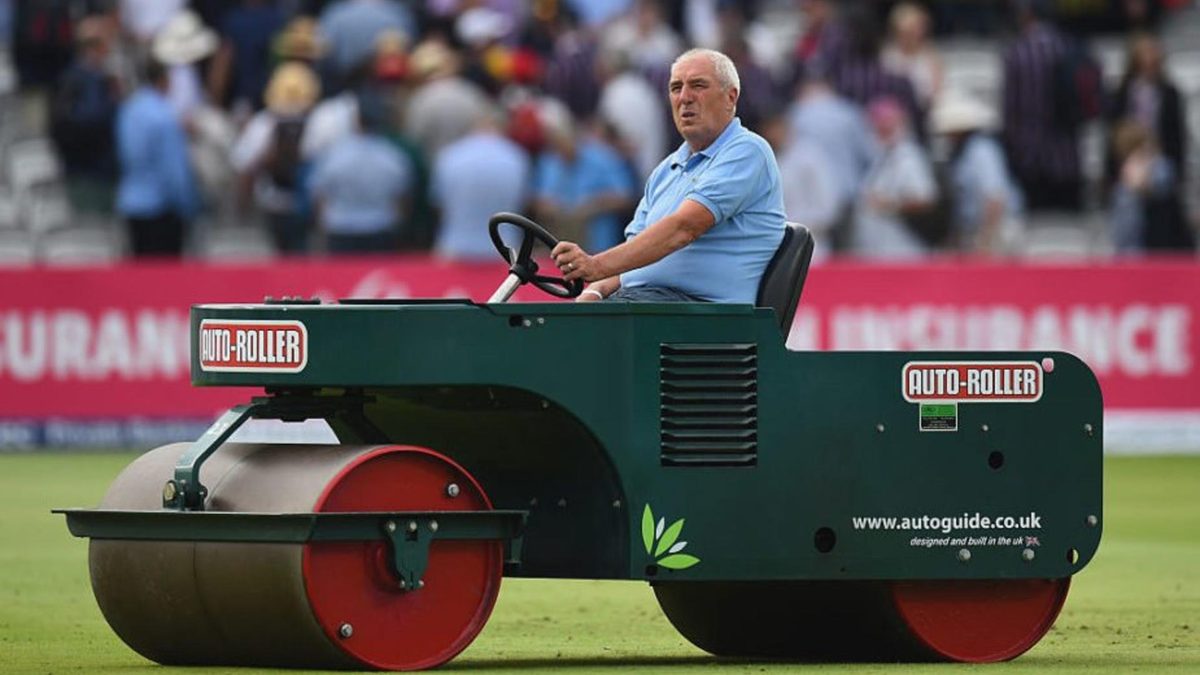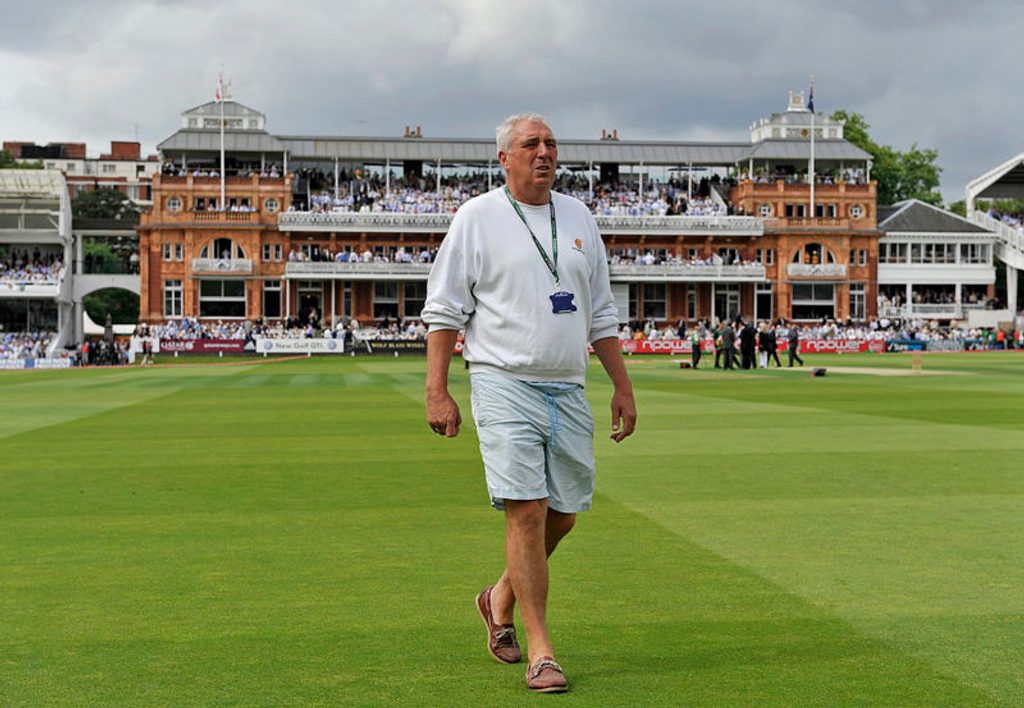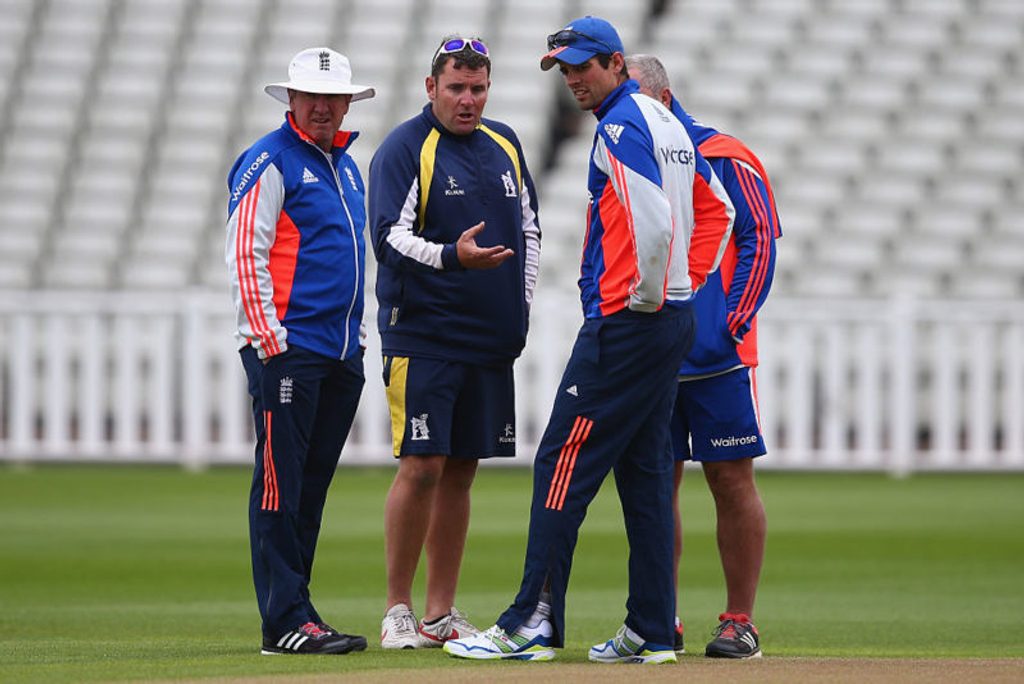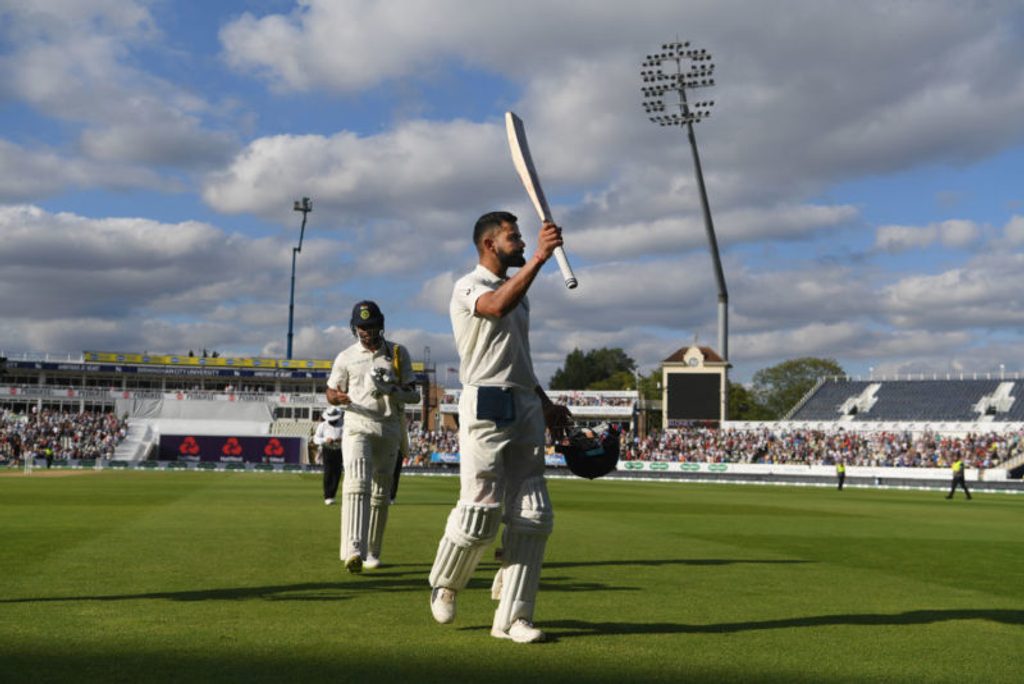
In the 2019 Wisden Cricketers’ Almanack, Jon Hotten explored the world of a key behind-the-scenes figure: the groundsman.
Jon Hotten is the author of The Meaning of Cricket. This article features in the 2019 Wisden Cricketers’ Almanack, which is available to buy here. The most famous sports book in the world has been published every year since 1864.
It was one of those days at Lord’s. The pitch looked a belter, but above the Pavilion full-bellied clouds had stalled in the skies. The air felt heavier. Mohammad Azharuddin, India’s captain, was wondering what to do if he won the toss, when he spotted the head groundsman, Mick Hunt.
“Bat first?” asked Azhar. Hunt looked at him: “You know what it’s like here: if it’s overcast it does swing. Fresh pitch, first day, bit of seam…” Azharuddin won the toss – and bowled. England declared almost two days later on 653 for four. Graham Gooch made 333. That evening, Azharuddin walked past Hunt again, and muttered something that rhymed with his surname. Nearly three decades later, Hunt allows himself a long chuckle. “That was one of my more memorable cock-ups.”
 Gooch makes 333. Not Mick Hunt’s finest call
Gooch makes 333. Not Mick Hunt’s finest call
Hunt began working at Lord’s in 1969, “doing a bit of fetching and carrying”. Peter Parfitt was captain of Middlesex, Harold Wilson prime minister, and the Krays on their way to jail. He had grown up within earshot of cricket itself, and raised his family – two sons and two daughters – in the groundsman’s house by the North Gate. His wife, a nurse, worked at the Wellington Hospital just over the road. “In the morning, she went out one door, I went out the other.”
On a crystalline September day, soon after his final fixture, he was facing up to leaving not just a cricket ground, but a way of life. “After 49 years it’s a hell of a wrench. I was born in St John’s Wood. I’ve lived here 44 years. I don’t know anything else, which is sad in some respects. My wife’s taking it quite bad, to tell you the truth.”
Hunt became head groundsman after Jim Fairbrother died in 1984, and since then has prepared pitches for 60 Tests, 49 one-day internationals (including the 1999 World Cup final), ten Twenty20 internationals, two women’s World Cup finals, numerous domestic finals, and more Championship and limited-overs games than he can remember. The demands of the fixture card are as unerringly regular as the taxman. “I got to the stage I was taking it home with me,” he says. “I’d wake up at ridiculous times thinking, ‘Christ, has it stopped raining out there yet?’ I won’t miss the stress or the pressure.”
 Hunt took on the role of head groundsman at Lord’s in 1984
Hunt took on the role of head groundsman at Lord’s in 1984
A diagnosis a decade ago of cancer, from which he is still recovering, and the passing seasons, have made him reflective. “I missed out big time. I wasn’t selfish in terms of personal gain, but I was selfish towards the kids: dad never took them out to the pictures or the seaside because dad was always working until September. Everything revolved around cricket. So this is a bit of payback time.”
Cricket remains an elemental game, dependent on leather and willow, the soil and the weather. The cut strip, unchanged in length since 1744, is its terra incognita, conjured with what Gary Barwell, head groundsman at Edgbaston, calls only half-jokingly “the dark arts”. A pitch is essentially simple, the earth rolled hard and held together by grass, yet no one – not even those preparing it – knows exactly how it will behave. Its mystery is innate, a sublime variation that can shape matches and careers.
Lord’s was once so notorious for its stone-pitted wicket that W. G. Grace received an ovation for keeping out three shooters in a row. And for many years the ground was so vulnerable to rain that heavy weather became known as “beer clouds”: an early close was inevitable. But a drainage system installed in 2001 proved a marvel of engineering, with a filtration rate of an inch of water per hour. “What you’re looking at,” says Hunt, waving a brawny arm at his outfield, “is the biggest golf green in the world.”
It is a golf green that was kept short by sheep until the arrival of the mower in the middle of the 19th century. But the pitch remained treacherous for decades: George Summers died in 1870 when a ball struck a stone, then his head. As the County Championship took shape, so did the notion of a specialist groundsman. At Trent Bridge, “Fiddler” Walker introduced top-dressing with fertiliser, and pitches were properly rolled and cut. Even so, it was perhaps not until Harry Brind persuaded the Surrey committee to allow him to dig up the Oval square in the late 1970s, transforming its sluggish surfaces by underlaying them with Ongar loam trucked in from the construction of the M11, that science began to have its way.
For the groundsman, technology has become a reassuring presence. The Clegg Hammer looks a bit like the dynamite detonator from a kids’ cartoon, and measures the pitch’s hardness. A tensiometer, or soil moisture sensor, does what it says on the tin. These numbers – ideally around 240–260 on the Clegg, and 28–30% moisture – offer empirical evidence to soothe a feverish brow. Yet groundsmen are still subject to the whims of nature and the players, on whom perception of their work so often depends.
Every pitch in the English professional game will receive a grade from a cricket liaison officer, known as the “CLO” – a position Hunt, in what may be a Freudian slip, calls “the PLO”. The CLO’s sanctions include a points deduction. Playing time lost is money lost, and the quality of the wicket is a commercial imperative. Hunt remembers when county pitches could be like the Wild West. “One or two were at it,” he smiles. “Notts were notorious, with Hadlee and Rice. I’ve heard stories of visiting teams who couldn’t tell where the pitch was, there was so much grass. Other grounds were green at one end and bare at the other. I was told by one coach he’d seen someone using wire brushes on a spinner’s length. Stories used to go around about home sides – if they’d batted first, they’d put a flat sheet down that night, and you get the greenhouse effect. Those days are over.”
Gary Barwell began at Grace Road on the Youth Training Scheme, earning £30 a week. He had fallen in love with groundsmanship during a placement at Leicester City’s Filbert Street, hallowed turf for a lifelong fan. Leicestershire sent him to agricultural college, where he studied greenkeeping, as there was no course specifically for cricket (“I’m qualified to rake a bunker on the European Tour”). His first job was painting sightscreens and dressing-rooms. Then came his first nets, cut on the outfield, that turned like a Hyderabad dustbowl: “They looked white, but this lad called Carl Crowe, a batter who bowled a bit, ragged it square. It taught me a lot.” Next was the new second-team ground at Hinckley, where he worked under Andy Ward and Andy Whiteman. He moved to Trent Bridge as a deputy, before getting the Edgbaston job in 2011.
 Barwell in discussion with Trevor Bayliss (left), Alastair Cook (second from right) and Paul Farbrace (right), July 2015
Barwell in discussion with Trevor Bayliss (left), Alastair Cook (second from right) and Paul Farbrace (right), July 2015
As he speaks, he gives the sense of an industry slowly pulling itself together. A few days earlier, he had been in Madrid at a meeting that included counterparts from Arsenal, Wimbledon and the Hurlingham Club. Barwell has a strapping medium-pacer’s physique, a sharp intelligence and a strong sense of duty. He mentions his wife, a deputy head teacher, often.
“Emotionally, you go up and down,” he says. “When I was at Leicester, we were playing Yorkshire. They’re four for three, Vaughan’s out, McGrath’s out. But you know in your heart there’s nothing wrong with the pitch. Andy Ward is pacing up and down, but Andy Whiteman’s reading a broadsheet newspaper. I spoke to him about it later, and he said: ‘I might have been sitting down, but inside I was totally drained.’ I learned from him that if I got in charge, whatever happened on a pitch, I would put on me, not hand it down to my staff.”
A groundsman’s nightmares are populated by cataclysms of the past. There was Headingley’s Fusarium Test during the 1972 Ashes, a rare sporting occasion named after a fungus; the abandonment at Sabina Park in 1997-98 on a pitch apparently relaid, wrote Mike Selvey, “by a cowboy gang of tarmac layers”; even Edgbaston 1995, when England lost 20 wickets in 75 overs after Curtly Ambrose’s first ball sailed off a length, over Mike Atherton’s head, and all the way to the boundary.
The pressure can be all-consuming. The first session of a Test is about as bad as it gets. “Terrible,” says Hunt. “And then five days of torture.” Barwell says he feels physically sick before the first ball: “You have the weight of the world on your shoulders.”
If the arts remain dark, cricketers still like to think they know a little about them. Like amateur golfers borrowing the pros’ routines from TV, cricketers stare at the grass, assess its length and colour, look for telltale patches or cracks – even, in the long dry summer of 2018, for dust. Perhaps they’ll bang a heel into it, or rub the back of their hand against it, offering a pithy “road”, or a sage “might do a bit”.
But how good a judge is the average player? “Oh, useless, absolutely,” says Hunt, tongue only partially in cheek. “They haven’t got a clue. I could pull my mum out there – she’s 94 and she’d have more idea.” He recalls the last game of the season, played on a used strip with some cracks, but ones not even the roller could move. “So the players come out, and they start on the cracks with their bats. I mean, that’s brainless. It’s like a Formula One driver taking a hammer to his engine. Doesn’t make sense.”
Barwell remembers an exchange with Robin Smith, towards the end of his career. “He was an absolute legend to me as a kid. Hampshire were at Grace Road, and I went over, second day of the game. I was 18, hadn’t had six months’ experience. I asked him: ‘Which roller would you like?’ He said: ‘Which one do you reckon?’ And I said: ‘Look, I’m just a kid.’ He said: ‘Well you probably know better than me.’ This is Robin Smith, one of the bravest, strongest players to have represented England. So I’d say about 20% know what it is to do a pitch.”
Hunt’s eyes twinkle when he talks about the players he has known, the long relationships with successive Middlesex captains, maintained through fair weather and foul. He and Mike Brearley once watched the covers float down the hill to the Tavern. Mike Gatting was a maestro at talking to Hunt within earshot of the umpires. “If he was in a winning position when it rained, he’d march out – ‘Mick, I can’t believe what a great job you’ve done here.’ If he was in a losing position, it’d be: ‘Ah dear, look at this, can’t believe how much rain we’ve had.’”
Barwell recalls a conversation with Ian Bell, who explained how it felt when the ball wasn’t quite coming on to the bat. “He wants to see it leave the hand and play his shot. I just thought, if it’s slower, it’s easier to hit. It’s all about communicating with your players.”
The summer of 2018 began in the deep chill of April, but became the hottest on record, interspersed with biblical downpours. Village outfields burned to the colour of autumn leaves. Barwell pumped 46,000 litres of water on to Edgbaston every 36 minutes, the length of his sprinkler cycle. Hunt dared not contemplate the bill MCC received from their water supplier.
 “I was privileged to produce a pitch that Virat Kohli scored 149 on”
“I was privileged to produce a pitch that Virat Kohli scored 149 on”
It was a classic batsman’s summer, and yet the ball was dominant. The Edgbaston and Lord’s Tests against India were remarkable pieces of theatre. Birmingham featured a deathless duel between Virat Kohli and James Anderson, when Kohli’s bat seemed enchanted in so many ways; at Lord’s, England won in 170.3 overs, their third-shortest home Test in a century. “Poor India, it just swung, they didn’t have a chance,” says Hunt. “It was bizarre, almost like the Bob Massie conditions in 1972. Then the sun came out for England: different ball game.”
Barwell walks out on to Edgbaston, talking about the Test and the summer. In the grand stillness of an empty stadium, he is almost transported as he remembers Kohli. “I was privileged to produce a pitch that Virat Kohli scored 149 on,” he says. “It was a great game, and when you see all the tweets and people talk about the wicket, it’s a joy to come to work.”
The Edgbaston square seems to stretch out like a pleasure beach: it has 24 pitches, 17 for first-class cricket. Eight are TV pitches, with cameras directly behind each end. They are one of the banes of a groundsman’s life, putting even more pressure on a square that is in almost constant use.
“Next year will be the busiest ever,” says Barwell, referring to 2019. “We’ve got eight TV pitches – and five World Cup games, an Ashes Test and T20 finals day. That’s not including any Warwickshire TV games. On top of that, you’ve got pressure from the ICC – they want particular ones. Last year, we had home quarter- and semi-finals in the Royal London Cup which needed TV pitches…”
Like a schoolboy doing his times tables, Barwell can recite his routine. “Getting moisture in the pitch starts 14 days before. We start rolling 13 days out. We generally don’t lose more than 7% moisture in that period. Put your heavy roller on – just under three ton – at the start for two hours. Twelve days out, another two hours. Then the regular roller. It’s like a plasterer doing a wall. He’ll skim it with water, then smooth it. If we can roll a pitch for eight hours or more, it’ll be pretty good. Anything under, it seems to lack a little bit. I call it the ‘magic eight hours’. Nine days to go, we bring out a combi-brush – a little rake that stands the grass up and dries out the moisture.”
Barwell has hit on a method of keeping the grass longer, which adds carry and pace to the pitch but leaves it dry, avoiding the dreaded greentop. In his office, tucked away under the stands by the storage space for his gleaming rows of mowers and rollers, he keeps his notes: the readings, scores, results and marks of every pitch he’s made.
Hunt performed a similar juggling act on the Lord’s square, from which he summoned two Test pitches a year in addition to the Middlesex schedule. He could squeeze in 20 and still maintain – just – the 50-yard boundary demanded by playing regulations. Each Test wicket had a three-week no-go zone around it. “Maybe the Test is on pitch ten, then you’ve got people running up and down pitch 11 for five days, so you have to put a one-day game on that one.”
When Hunt began, even the Test wicket was seen up close by the players and umpires alone. Now it is examined by ultra-HD cameras and super slo-mo replays, and may be pressed and tapped and car-keyed by squadrons of former players from the commentary box. Media scrutiny is harsh and sapping; groundsmen, like elephants, never forget.
“Three balls into the India Test, Ebony Rainford-Brent is saying there’s nothing in this pitch,” recalls Barwell, evenly. “How can you make an assumption like that? I’ve got no problem if they say: ‘Well, nothing’s happened to the first two or three balls.’ But everyone listening has already heard it. I’ll always protect my pitch. The first year we were here, we had the wettest summer on record. Nasser Hussain stood on the square, on the mike, and said: ‘We’re not starting because the run-ups are wet.’ I asked why he said that. He replied: ‘Well, it sounds better than the outfield’s wet.’ Usually, the better players will talk. Shane Warne will always walk over and ask about the pitch. The wife says: ‘Oh, you spoke to them today, didn’t you? What they’ve just said is exactly what you’d say.’”
Hunt concedes: “They’ve got to talk about something, I suppose. What is frustrating is they set their stall out after three or four overs. We’ve got 90 overs a day. And they won’t admit they’re wrong: ‘Oh, the sun’s out now, it’s got a bit more pace.’ And some of the stuff in the papers – you wonder if the guy was actually here…”
Hunt has been honoured with life membership of MCC (“I’ll be here shouting: ‘Get on with it!’”), and one thing is certain: no other groundsman will have a career like his, when arcane knowledge was transformed into the scientific application of an ancient art. He has been left with a thousand stories, every one a jewel: the time Viv Richards defended his pitch from media criticism after England’s batsmen got out gloving and fending West Indies’ quicks; Brearley arguing on the outfield with Imran Khan while Wayne Daniel bowled at the speed of light (“He started his run-up in the top tier of the Pavilion”); Kapil Dev, in that long-ago Test where Azharuddin got his bum steer, lifting four sixes in a row to avoid the follow-on.
Maybe he should think about a one-man show. “You know what I’d like? Wherever I end up, if there’s a little club, I’ll just sneak along: ‘Do you mind if I sit on your roller for a couple of hours, help you out?’” He laughs once again. “They’ll go, ‘Oi lads, we’ve got one here. Says he used to be head groundsman at Lord’s…’”








